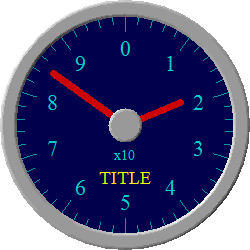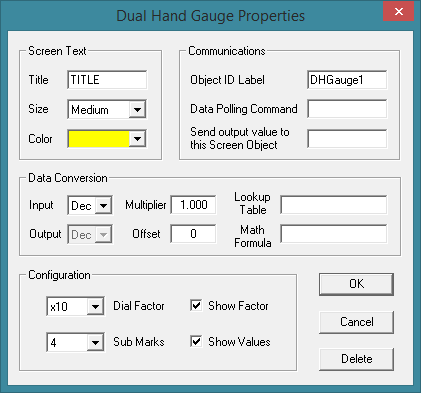|
ERROR!
You must enable Java Script on your browser to navigate this site. |
||
Dual Hand GaugeA Dual Hand Gauge is a Screen Object which is used to display live data in the form of a continuous circular dial with two rotating needles similar to an altimeter gauge in an aircraft cockpit. It can be configured to accept data from another object within ModCom, or to automatically poll an external  Once a Dual Hand Gauge is placed on the screen it can be selected by clicking on it with the left mouse button. To move the object, place the cursor over it, hold down the left mouse button and drag the object to the desired position. Resize handles are provided to allow adjustment of the overall size by dragging on them with the mouse in a similar fashion. To set the properties of a Dual Hand Gauge, Properties Dialog Box: Screen Text:Title: Type in the text that will appear on the bottom of the gauge. Size: Selects the font size used for the text characters in the gauge. Making changes to this attribute will also change the overall size of the gauge respectively. Color: Selects the font color used for the characters in the title. Communications:Object ID Label: Type in a label that will be used for identification by other objects within ModCom when sending data to the gauge, using the displayed reading as a variable in another object's function, or when evaluating Conditional statements specific to the gauge's value. Data Polling Command: If wishing the Dual Hand Gauge to continuously grab data from a Send output value to this Screen Object: To send the current Dual Hand Gauge value to another Screen Object for viewing, type in the object's ID label here. This object can be a Data Conversion:Input: Set this to the data format (Decimal, Binary, or Hexadecimal) which equals the format of the data being returned by the DAQ Module. Output: This feature is not used for this type of gauge and is disabled. Multiplier: Type in the multiplication factor which should be applied to the data before it is displayed. This can be a whole number as well as a number containing digits to the right of the decimal point. Offset: Type in the offset value which should be added to or subtracted from the data before it is displayed. This can be a whole number as well as a number containing digits to the right of the decimal point. Note, by default, the resolution of the data will use the same number of digits to the right of the decimal point as the original data which was received from the Lookup Table: To convert the data using a lookup table of known substitution values, type in the filename which contains the table. If the full PATH name is not included, the file will be searched for in the current directory as shown in Math Formula: To convert the data using a mathematical expression, type in a formula here. This formula can contain the four basic arithmetic operators Configuration:Dial Factor: Select the multiplication factor to be used for the dial faceplate. Each number on the dial will represent itself multiplied by this factor. Sub Marks: Select the number of sub marks to show Show Factor: Check this box to show the Dial Factor on the faceplate. This text will be positioned just above the Title text. Show Values: Check this box to show the numbers on the dial faceplate. Maximum Data Range:The Dual Hand Gauge will only display data which falls within it's range. Since there are two needles on the gauge and 10 numbers around the dial, the maximum range is equal to
|